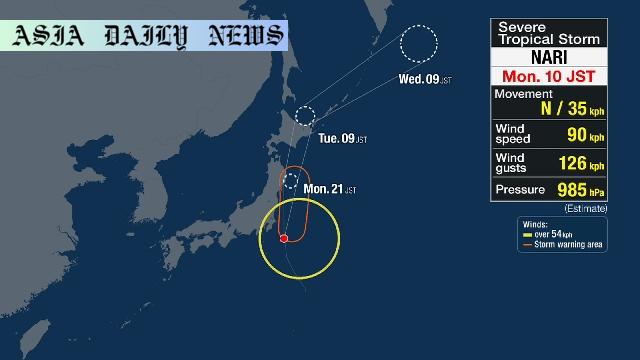Tropical Storm Nari set to impact eastern and northern Japan, with heavy rains, strong winds, and severe weather warnings issued.
- Tropical Storm Nari to impact eastern and northern Japan.
- Severe weather includes heavy rain, strong winds, and flooding.
- Up to 200mm rainfall expected in Tokai region through Tuesday.

Overview of Severe Tropical Storm Nari’s Trajectory
Severe Tropical Storm Nari is projected to bring unprecedented weather conditions to Japan, predominantly affecting the eastern and northern regions. As of 10 a.m. on Monday, the storm is described as traveling northwards at a speed of 35 kilometers per hour, positioned over waters 170 kilometers south-southeast of Choshi City in Chiba Prefecture. The Japan Meteorological Agency (JMA) reports Nari’s central atmospheric pressure at 985 hectopascals, with winds reaching speeds of 90 kilometers per hour and gusts of up to 126 kilometers per hour near its center. Strong winds exceeding 54 kilometers per hour extend up to 440 kilometers on its eastern side and 220 kilometers on its western flank.
Predictions suggest Nari will travel north, passing east of the Kanto region by Monday night, before heading off Sanriku’s coast. On Tuesday, the storm is expected to approach Hokkaido, potentially transforming into an extratropical low-pressure system. High waves have already been reported in the Ogasawara Islands, situated south of Tokyo, signaling the strength of the approaching storm.
Severe Weather Warnings for Affected Regions
Weather officials have issued warnings to residents in the affected areas, particularly eastern and northern Japan, as the storm’s intensity builds. By Tuesday, Nari is expected to make landfall, with strong winds forecasted to hit regions such as Tohoku and Kanto. Winds in these areas could reach speeds of up to 90 kilometers per hour, with gusts of 126 kilometers per hour. In the Izu Islands, winds at 64.8 kilometers per hour with gusts up to 90 kilometers per hour are anticipated. These conditions raise concerns about potential power outages, damage to infrastructure, and public safety.
The impact is not limited to winds—intense rainfall is also expected. The Tokai region, in particular, is on high alert, with forecasts of heavy rain bands forming from Monday night through Tuesday noon. Rain-triggered disasters such as landslides and flooding in low-lying areas are possible. The meteorological agency has highlighted areas prone to landslides and advised caution, particularly around rivers and waterways prone to overflowing.
Rainfall Expectations and Flood Concerns
In the 24 hours leading up to Tuesday morning, extremely heavy rainfall is expected across multiple regions. Tokai may receive up to 200 millimeters of rain, while Shikoku could experience 180 millimeters. Meanwhile, the Kinki region may see up to 80 millimeters, with southern Kyushu and Chugoku following closely with similar predictions. In the 24 hours before Wednesday morning, an additional 150 millimeters of rain could affect the Tokai region, and another 200 millimeters may strike in the subsequent 24-hour period until Thursday morning.
The rain clouds over western Japan are forming due to a tropical depression near Kyushu, along with a low-pressure system over the Tsushima Strait. This combination of factors has created an extremely unstable atmosphere, fostering conditions for localized downpours, lightning, and even the potential for tornadoes. Officials also emphasize the risk of hail and power outages caused by sudden gusts of wind.
Emergency Preparedness and Public Advisories
The Japan Meteorological Agency continues to caution residents about the increasing risks of natural disasters due to severe weather. They are urging people to prepare for landslides, secure property to avoid wind damage, and stay updated via weather alerts. Flooding in low-lying areas can occur rapidly, leaving limited response time for evacuation or safety measures. Officials recommend creating an emergency kit, identifying local shelters, and staying connected to neighbors who may require assistance.
The government is collaborating with local authorities to ensure that evacuation centers are accessible and adequately supplied. Residents in urban areas are encouraged to minimize travel during these conditions, and those in rural or mountainous terrain should be particularly cautious about landslides and road collapses.



Commentary
Understanding the Growing Intensity of Weather Patterns
The arrival of Severe Tropical Storm Nari highlights the increasing frequency and intensity of extreme weather events, particularly in regions like Japan, which are already prone to typhoons and storms. As this storm showcases, powerful weather systems not only pose immediate risks to life and property, but they also underline the broader implications of climate change and the urgent need for preparedness and resilience. It’s clear that such storms demand a proactive response—one that combines meticulous monitoring with swift, collective action at both governmental and community levels.
The Role of Predictive Technology in Disaster Management
Fortunately, advancements in meteorological technology allow for more precise tracking of storms like Nari. Detailed data on wind speeds, pressure systems, and rainfall predictions enable authorities to issue timely warnings and prepare communities in advance. However, even with cutting-edge technology, effective disaster management relies on people heeding these alarms and acting swiftly. Public awareness campaigns must encourage citizens to take precautions, from securing their homes to having an evacuation plan in place. While technology sets the stage, human collaboration ultimately prevents disasters from becoming catastrophes.
Resilience and Hope Amidst Challenges
Despite the challenges posed by Tropical Storm Nari, there is a sense of resilience among affected communities. Japan has long demonstrated its ability to adapt to and recover from natural disasters, relying on both its technological prowess and the collective strength of its people. While storms like Nari test the limits of preparedness, they also provide opportunities to improve systems, build stronger infrastructure, and foster greater environmental awareness. In the face of these adversities, it becomes essential to find hope and work together to mitigate the effects of climate-related disasters.